|
TMT
emerged with Ankara’s support as a powerful force, and exercised a crucial
influence over the affairs of the Turkish-Cypriot community. One of its
founders was Rauf Denktash, the current Turkish Cypriot political spokesman
in occupied Cyprus.
The decision to create
TMT was taken at the highest levels of the Turkish Menderes Government in
Ankara. While facing mounting pressure from public opinion, the Turkish
Government decided to use the Cyprus question as a diversion to keep the
Turkish military quiet, an ever present factor in Turkish politics: that is
how TMT was conceived. TMT fighters were trained, armed and led by a small
group of well-disciplined Turkish officers. It established cells in towns
and villages throughout Cyprus, and it selected personnel who were to be
sent to Turkey for military training. It was also to become the
organisational tool through which the geo-political partitionist policy of
Turkey was to be enforced in Cyprus. It was a policy which aimed at
segregating the Turkish and Greek Cypriots from each other as a prelude to
the physical division of the island.
During the course of
1957, TMT pressured the Turkish Cypriots into withdrawing from any
co-operative ties they had with the Greek Cypriots and, on the whole, they
were successful; this policy later became known as the `from Turk to Turk
policy’. Such encouragement was entirely alien to the co-operation and
quiet existence which had always prevailed between Greek and Turkish
Cypriots, but was necessary to sow the seeds of partition. A similar policy
was followed in Istanbul, organised by the Turkish National Student
Federation, which had worked closely with Kibris Turktur in its planning of
the anti-Greek riots there back in 1955.
In Cyprus this crude
policy of enforced segregation did not go unopposed amongst the Turkish
Cypriots. TMT’s answer to criticism was however rapid and brutal. It
assassinated prominent Turkish Cypriots who dared to publicly voice
opposition or advocated co-operation between Greeks and Turks. The most
widely known such murders were those of Fazil Ondur, the chief editor of
the weekly newspaper Inkilapci, who was killed on 29 May 1959; and Ahmet
Yahaya, a committee member of the Turkish Cypriot Athletic and Culture
centre, who was killed on 5 June 1958. An attempt was also made on the life
of Arif Barudi on 3 July 1958, and another one on Ahmet Sadi, the director
of the Turkish office of the Pancypriot Labour Federation who, soon after
the attempt against his life, left Cyprus to settle in England. The same
policy continues today with the assassination in July 1996 of Kutlu Adali,
the Turkish Cypriot journalist, who had the courage to condemn the
partitionist project of the Turkish military establishment which leads the
foreign policy of Ankara, and who advocated closer co-operation between
Greek and Turkish Cypriots.
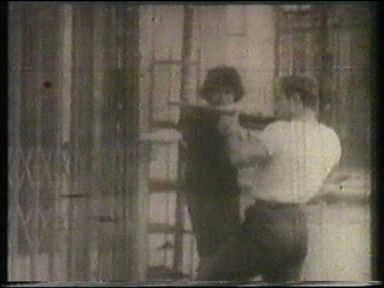 TMT’s strategy was one
of incitement in the hope of provoking inter-ethnic conflict with the aim
of securing the separation of the two communities. It did so without any
consideration to likely casualties amongst innocent Greek and Turkish
Cypriots. The first such serious inter-communal fighting began in June 1958
and was the result of such incitement which the Turkish authorities have
subsequently been candid on a number of occasions. Mr Emin Dirvana, a
former Turkish diplomat, said: `I was informed that on 7 June 1958 a bomb
had been planted in the Turkish press office in Nicosia by persons who, as
was later established, had nothing to do with the Greek Cypriots. The Turks
of Nicosia were then incited to be overwhelmed by holy indignation and
perpetrated acts similar to those committed on 6 and 7 September 1955 in
Istanbul.’ TMT’s strategy was one
of incitement in the hope of provoking inter-ethnic conflict with the aim
of securing the separation of the two communities. It did so without any
consideration to likely casualties amongst innocent Greek and Turkish
Cypriots. The first such serious inter-communal fighting began in June 1958
and was the result of such incitement which the Turkish authorities have
subsequently been candid on a number of occasions. Mr Emin Dirvana, a
former Turkish diplomat, said: `I was informed that on 7 June 1958 a bomb
had been planted in the Turkish press office in Nicosia by persons who, as
was later established, had nothing to do with the Greek Cypriots. The Turks
of Nicosia were then incited to be overwhelmed by holy indignation and
perpetrated acts similar to those committed on 6 and 7 September 1955 in
Istanbul.’
In the ITN documentary
`Cyprus, Britain’s Grim Legacy’ the account continues:
`The explosion sparked
off a night of riot in Nicosia. Turkish Cypriots burned and looted Greek
shops and homes. Soon came counter attacks and the fighting spread around
the island. A friend of mine, whose name must still be kept secret, was to
confess to me that he had put this little bomb in the doorway in order to
create an atmosphere of tension so that people would know that the Turkish
Cypriots mattered.’
In fact, nobody had
ever claimed that the Turkish Cypriots did not matter. This reveals the
essence of the matter, that the Turkish Cypriot leadership, first in
Ottoman times and then during the British administration, had always
occupied a position of political privilege as an ally of the occupying
power. These privileges were not something the leadership were willing to
give up. During early British rule, the alliance with the Turkish minority
became clear in the legislative council. It worked on the principle that
the British and Turkish members at least equalled or outnumbered by one
vote the Greeks.
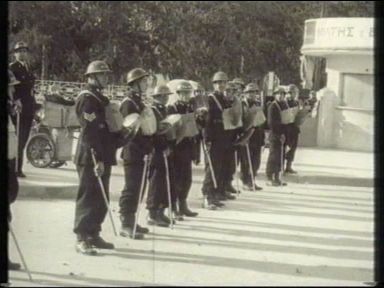 The tactics of TMT, to
provoke ethnic conflict when none would otherwise have arisen, were soon to
be successful. On 12 June 1958, following the press office bomb explosion,
British security forces rounded up eight Greek Cypriots from the village of
Kondemenos and subsequently released them near the Turkish Cypriot village
of Guenyeli, approximately seven miles from where they were arrested, and a
good distance from the nearest Greek villages; the released Greek Cypriots
were subsequently massacred by Turkish Cypriots acting on the orders of
TMT. These were the first reported inter-communal killings. These killings
were carried out in the certain knowledge that Greek Cypriots would also
carry out revenge attacks. The tactics of TMT, to
provoke ethnic conflict when none would otherwise have arisen, were soon to
be successful. On 12 June 1958, following the press office bomb explosion,
British security forces rounded up eight Greek Cypriots from the village of
Kondemenos and subsequently released them near the Turkish Cypriot village
of Guenyeli, approximately seven miles from where they were arrested, and a
good distance from the nearest Greek villages; the released Greek Cypriots
were subsequently massacred by Turkish Cypriots acting on the orders of
TMT. These were the first reported inter-communal killings. These killings
were carried out in the certain knowledge that Greek Cypriots would also
carry out revenge attacks.
Turkey rushed to put
forward a formal protest to Britain the day following the press office
bomb, alleging that the Cyprus administration had failed to give the
Turkish minority adequate protection. `Cyprus, partition or death, was the
slogan constantly repeated by Turkish leaders and the armed paramilitaries.
The claim was that Turkish Cypriots could not think of themselves as being
integrated into Cypriot society. The fact that they already were,
necessitated a strategy of tension and forced separation.
The principle of
partition was not based on the realities of Cypriot society at the time,
but on Turkey’s perceived security requirements alone. In the Summer of
1958, in the mixed suburb of Omorphita in Nicosia, TMT evicted 700 Greeks
from their homes. By the end of July 1958 a much clearer line had been
drawn between the Greek and Turkish quarters. The reluctance of British
authorities to deal even-handedly with the violence became clearer when the
partisan decisions made by the Courts at the time is taken into account.
Whereas Turks arrested for participating in the riots were released, Greeks
received custodial sentences for minor offences.
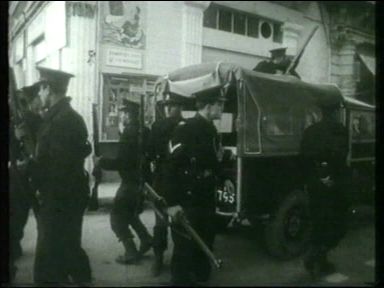 Sixteen Turks were, for
example, arrested by the British authorities for complicity in the Nicosia
riots, but they were released on condition that they stayed in at night. A
Turkish policeman, sergeant Tuna, was charged with possessing a bomb and
ammunition for which the mandatory penalty was clearly the death penalty.
He was released and left immediately for Turkey. The only official piece of
evidence that Turkish policeman were involved in bomb attacks had
conveniently `disappeared’. By contrast, two Greeks who pulled down a Union
Jack were each given 18 months prison sentences, whilst those subsequently
involved with the possession of fire arms were hanged. In hindsight, it is
hardly surprising that Greek Cypriots saw a conspiracy against their
struggle for self-determination from British and Turkish Cypriot sources. Sixteen Turks were, for
example, arrested by the British authorities for complicity in the Nicosia
riots, but they were released on condition that they stayed in at night. A
Turkish policeman, sergeant Tuna, was charged with possessing a bomb and
ammunition for which the mandatory penalty was clearly the death penalty.
He was released and left immediately for Turkey. The only official piece of
evidence that Turkish policeman were involved in bomb attacks had
conveniently `disappeared’. By contrast, two Greeks who pulled down a Union
Jack were each given 18 months prison sentences, whilst those subsequently
involved with the possession of fire arms were hanged. In hindsight, it is
hardly surprising that Greek Cypriots saw a conspiracy against their
struggle for self-determination from British and Turkish Cypriot sources.
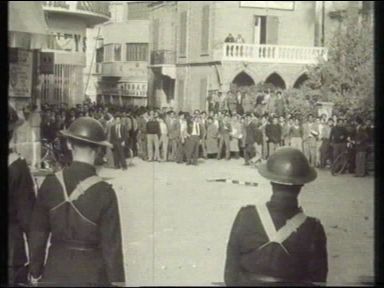 The riots in Nicosia
caused by the bomb in the Turkish press office, resulted in the deaths of
56 Greek and 53 Turkish Cypriots. The higher number of Greek casualties
demonstrates that the Turkish Cypriots (who of course were outnumbered in
Cyprus 5:1 by Greek Cypriots) had, on the orders of TMT, pre-arranged
strongholds and were thus able to fight from a much stronger position than
their numerical inferiority would suggest. Clearly, by the end of 1958 the
Greek Cypriot demand for self-determination was still unacceptable to both
Britain and Turkey, although a new compromise needed to be worked out. The riots in Nicosia
caused by the bomb in the Turkish press office, resulted in the deaths of
56 Greek and 53 Turkish Cypriots. The higher number of Greek casualties
demonstrates that the Turkish Cypriots (who of course were outnumbered in
Cyprus 5:1 by Greek Cypriots) had, on the orders of TMT, pre-arranged
strongholds and were thus able to fight from a much stronger position than
their numerical inferiority would suggest. Clearly, by the end of 1958 the
Greek Cypriot demand for self-determination was still unacceptable to both
Britain and Turkey, although a new compromise needed to be worked out.
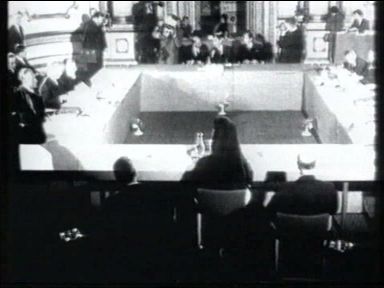 The London-Zurich
agreements of 1959 finally set up the Republic of Cyprus with Archbishop
Makarios III being duly elected its first President, and Dr Fazil Kutcuk
its Turkish Cypriot Vice President, by their respective communities in
December 1959. The Republic of Cyprus officially came into being on 16
August 1960. The London-Zurich
agreements of 1959 finally set up the Republic of Cyprus with Archbishop
Makarios III being duly elected its first President, and Dr Fazil Kutcuk
its Turkish Cypriot Vice President, by their respective communities in
December 1959. The Republic of Cyprus officially came into being on 16
August 1960.
Under the terms of the
1960 constitution, there was to be a fixed ratio of 70 Greek Cypriot
employees for every 30 Turkish Cypriots employed by government agencies.
The Turkish Cypriot leadership demanded that this parity of employment be
attained within five months of independence. The public service commission
pointed to the numerous difficulties of drawing 30% of the civil service
including the police force from just 18% of the population. As a result,
numerous posts remained unfulfilled in the search for suitably qualified
Turkish Cypriot candidates.
Since a majority vote
of the Turkish Cypriot deputies in the house was needed to pass tax
legislation, the Turkish Cypriots used it as a bargaining tool to force
compliance over the 70:30 ratio and various other issues which had as their
objective the continued segregation of the two ethnic groups. For example,
colonial laws had to be extended eight times while both communities
discussed legislation relating to separate municipalities. This provision
had been the greatest victory for Turkey in this settlement. The President
offered the Turks compensating safeguards, but was not prepared to
implement provisions which opened the way to partition. Deadlock inevitably
resulted again and again in a number of other areas.
Already by the end of
the 1961 the Turkish language press was calling for intervention by the
powers, meaning the UK and the US. In essence, there was a fundamental
belief on the part of the Turkish Cypriots in the eventual intervention of
Turkey to establish the partition of Cyprus. This belief underpinned their
unco-operative attitude towards the Greek Cypriots and, not surprisingly,
created the cycle of mistrust amongst Turkish Cypriots which culminated in
the crisis of 1963. Indeed, one of the starkest indications of the Turkish Cypriot
mistrust were the brutal political murders of Ayhan Hikmet and Ahmet
Gurkhan in 1962 by TMT. Both Hikmet and Gurkhan were publishers who
advocated closer association and co-operation between Greek and Turkish
Cypriots. TMT was again in action to ensure that the genuine voice of the
Turkish Cypriots was silenced, and this applied not only to journalists and
publishers, but to many political activists and ordinary people too.
|